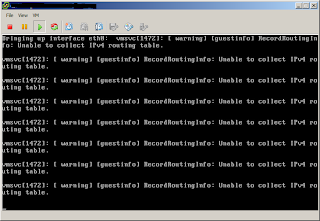As it turned out, what was supposedly a few clicks was more complex than what I thought. The clone virtual machines simply refused to boot. To give you a better understanding of the error see the screenshot below.
Opening the console of the virtual machine, the repeated errors prompted are:
vmsvc[xxx]: [ warning] [guestinfo] RecordRoutingInfo: Unable to collect IPV4 routing table. vmsvc[xxx]: [ warning] [guestinfo] RecordRoutingInfo: Unable to collect IPV4 routing table.
The messages above are repeated at about every minute.. And, worse, the boot sequence is stuck at this phase and will not proceed.
After exhausting my patience waiting for the host to boot up, I gave up and resorted to shutting down the virtual machines to figure out what was wrong. The VMware logs didn't give a clue what was wrong. Even RedHat forums didn't have information regarding the error.
What was striking was the "vmsvc" string, indicating this was somewhat VMware configuration related or a service related to VMware. This was happening to a RHEL Linux virtual machine. So I tried a different flavor of Linux -- CentOS. Same result. But for Windows Server 2003, it was not.
Google search came out with this same exact error message on the VMware Knowledge Base (KB #2048572). Executing the procedure in the resolution part did not help either.
It only applied when the guest operating system's time is ahead of the host. But that gave me a further clue -- how about if the time of the cloned guest is too far off from the host ESXi host? (Afterall it was converted to a template a while back. And it was not selective, as every cloned machine displayed this manifestation.)
It turned out this was the case. I decided to disable time synchronization completely between the host ESXi and guest RHEL virtual machine.. Bingo error gone.
A. To completely disable the time sync between the host ESXi hypervisor and the guest RHEL virtual machine, simply shutdown or power off the guest virtual machine and edit the .vmx configuration file. Add the following lines, if they don't exist:
tools.syncTime = "0" time.synchronize.continue = "0" time.synchronize.restore = "0" time.synchronize.resume.disk = "0" time.synchronize.shrink = "0" time.synchronize.tools.startup = "0" time.synchronize.tools.enable = "0" time.synchronize.resume.host = "0"
It helps to enable SSH on the ESXi server and use vi to make changes to the guest .vmx file. After adding the above lines, problem was solved and subsequent clones were easier.
The only task left to be done was to convert the template to a VM, make the same changes and re-template. This was a very fruitful learning experience.









